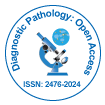Personalized Therapies in Hepatocellular Carcinoma: Insights from a Disulfidptosis-Related Signature
Received Date: Feb 12, 2024 / Published Date: Mar 18, 2025
Abstract
Hepatocellular Carcinoma (HCC) is the predominant pathological type of liver cancer with an unfavorable prognosis. Disulfidptosis is the newest cell death form and plays a vital role in tumorigenesis. However, the role of Disulfidptosis-Related Genes (DRGs) in HCC remains unknown. The RNA-seq and clinical data of HCC patients were obtained from The Cancer Genome Atlas (TCGA) and International Cancer Genome Consortium (ICGC) databases. Based on DRGs in TCGA cohort, the predictive model was established via regression analysis of the Least Absolute Shrinkage and Selection Operator (LASSO) and subsequently validated using ICGC cohort. Moreover, we investigated the relationship between predictive model and clinical features, somatic mutations, molecular mechanism, immune microenvironment and drug response. This study created an eight-gene signature. Here, we noticed a higher level of those eight genes in HCC patients in both RNA and protein levels. The patients in the high risk group had a poor prognosis. It was found the predictive model was an independent prognostic factor by Multivariate Cox analyses. Pathways involved in cancer, cell membrane and metabolism was significantly enriched. In addition, Tumor Mutation Burden (TMB) and immune checkpoint genes expression were higher in the high-risk group. Furthermore, the high-risk group was more sensitive to immunotherapy and some targeted therapy. We comprehensively and systematically identified a new disulfidptosis-related signature, which could serve as a valuable tool for predicting prognosis, immune cell infiltration and therapy response of HCC patients. Thus, these discoveries could have potentially clinical value in directing personalized therapies in the future.
Keywords: Hepatocellular carcinoma; Disulfidptosis; Prognostic signature; Tumor immune microenvironment
Citation: Wan Y, Xu D, Zhou Z, Ouyang Y, Zhang Z, et al. (2025) Personalized Therapies in Hepatocellular Carcinoma: Insights from a Disulfidptosis-Related Signature. Diagnos Pathol Open 10: 249.
Copyright: © 2025 Wan Y, et al. This is an open-access article distributed under the terms of the Creative Commons Attribution License, which permits unrestricted use, distribution and reproduction in any medium, provided the original author and source are credited.
Select your language of interest to view the total content in your interested language
Share This Article
Open Access Journals
Article Usage
- Total views: 243
- [From(publication date): 0-0 - Dec 16, 2025]
- Breakdown by view type
- HTML page views: 160
- PDF downloads: 83
